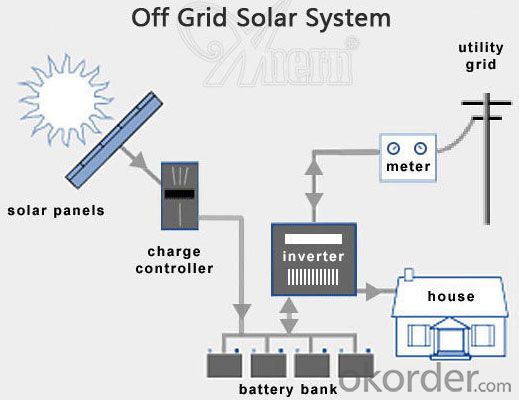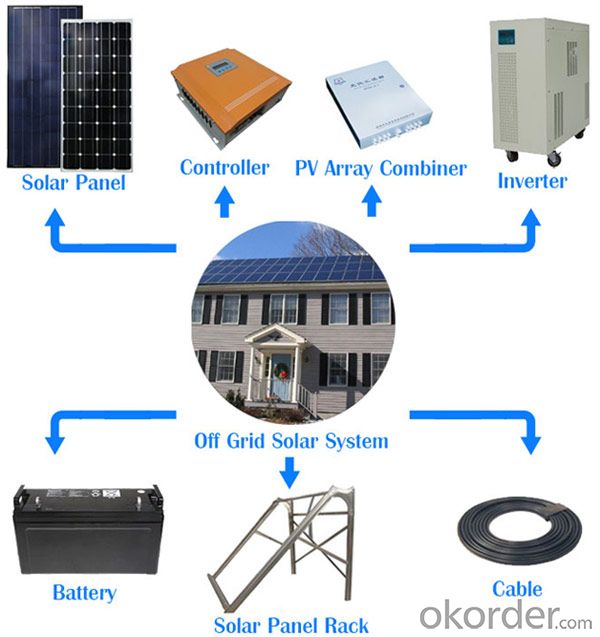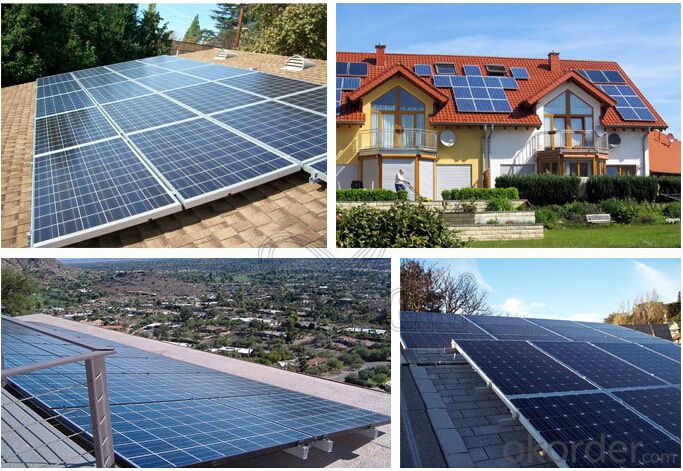Off-Grid Solar Power System 500W High Efficiency
- Loading Port:
- China main port
- Payment Terms:
- TT OR LC
- Min Order Qty:
- 1 pc
- Supply Capability:
- 10000 pc/month
OKorder Service Pledge
OKorder Financial Service
You Might Also Like
1.Description of Product
Off-Grid Solar Power System is consisted of solar panel, solar charge controller, inverter, battery, mounting rack and cables.
(1).Grid-connected, send power to city grid
(2).MPPT technology, wide range of working voltage
(3).Simply Wiring, easy installation, customized design for your projects
(4).Low investment & long term feedback

2. Off-Grid Features
1. Off grid solar power system is mainly used for application with relatively-small power consumption, and the areas have no grid network coverage, or grid power is unstable or outage condition.
2. It’s composed of solar panels, hybrid solar inverter, battery bank, solar panel mounting racks, and other accessories required fora complete home solar power system.
3. The battery bank gives a stable power output to the solar inverter which converts DC to AC to power loads, and provides power backup in rainy or cloudy days.
4. The solar panels generate electricity at daytime and charge the battery bank .
5. The off grid home solar power system provides grid power bypass in case of battery power shortage when sunshine is not enough.
6. All the off grid home solar power system configurations are worked out by scientific calculation and design.
The Product Parameter | |
Ref No. | 500W |
Solar Panel | Type: Monocrystalline Silicon PV Module Max Power: 250W QTY:2 pcs |
Controller-Inverter Integrator | Rated Ouput Power: 500W Rated DC Voltage: 24V QTY:1 pcs |
Battery | 12V/200AH per piece QTY:2 pcs |
Solar Panel Rack | Roof type mounting rack, anodized aluminum material, including complete fittings (Other type of racks can be customized as per client's requirement) QTY:1 pcs |
3.The Pictures of Product


4.FAQ
Q1: What is the business type for the company?
A1: We are one of the biggest manufacturers inBejing.Chnia. Which is a high tech PV enterprise dedicated to the research, development, production and sales..
Q2: How long solar panel warranty can you offer?
A2: 10-Year product warranty,25-year linear power output warranty
If there is any quality problem, we will pay for freight and send free parts to you.
Q3: How many certificates do you have?
A3: We have 16 certificates,such as CE, TUV, UL, and so on.
Q4: Can I be the agent for you?
A4: Yes,We can discuss some information.
Q5: How to get a sample?How can cooperation with us
A5: contact us now.
- Q:Can a solar energy system be installed in a remote location?
- Yes, a solar energy system can be installed in a remote location. Solar panels can be set up in areas that are far from the electric grid, allowing for the generation of clean and renewable energy in remote and isolated places. These systems can provide power for various purposes, including residential, commercial, and even off-grid applications such as remote cabins, research stations, or telecommunications infrastructure. As long as there is sufficient sunlight, a solar energy system can be installed and provide a reliable source of electricity in remote locations.
- Q:What is the role of disconnect switches in a solar energy system?
- The safe isolation of a solar energy system from the grid or other power sources is made possible by disconnect switches, which play a crucial role. During maintenance, repairs, or emergencies, these switches act as a safeguard by allowing the complete disconnection of solar panels or inverters from the electrical grid. A key function of disconnect switches is to protect both the system and the individuals involved in its operation. By preventing the flow of electricity from the solar panels to the grid, they ensure that no power is being generated or transferred during maintenance or repairs. This helps minimize the risk of electric shocks or accidents. In addition, disconnect switches help meet safety regulations and codes. They enable easy and quick disconnection of the solar energy system, which is often required during inspections or in the event of emergencies such as fires or natural disasters. By isolating the system, these switches help prevent any potential damage to the system or the grid. Furthermore, disconnect switches allow for efficient monitoring and control of the solar energy system. They provide a convenient way to shut down the system when necessary, facilitating troubleshooting or routine checks. By disconnecting the solar panels, inverters, or battery storage systems, these switches optimize the overall system's efficiency and performance. In conclusion, disconnect switches in a solar energy system ensure the safety of individuals involved, comply with safety regulations, protect the system and the grid from damage, and enable efficient monitoring and control. As an essential component, these switches enable the safe and effective operation of solar energy systems.
- Q:Are there any limitations to installing a solar energy system?
- Yes, there are a few limitations to installing a solar energy system. Some of the main limitations include the availability of direct sunlight, space requirements for installation, initial high costs, and dependability on weather conditions. Additionally, certain areas may have regulations or restrictions that limit the installation of solar panels.
- Q:How do solar energy systems affect energy bills?
- Solar energy systems can significantly reduce energy bills, as they generate electricity from the sun, eliminating the need to purchase as much energy from the grid. By harnessing solar power, homeowners can offset their electricity consumption, resulting in lower energy bills and potential savings.
- Q:Can solar energy systems be used in conjunction with wind energy systems?
- Yes, solar energy systems can be used in conjunction with wind energy systems. Both solar and wind energy are renewable sources and can complement each other in terms of their availability and energy generation patterns. Combining both systems allows for a more consistent and reliable energy supply, as solar energy is typically more abundant during the day, while wind energy is often stronger at night and during different seasons. By integrating solar and wind energy systems, we can maximize the overall energy output and enhance the sustainability of our power generation.
- Q:What is the role of solar energy systems in reducing energy poverty?
- Solar energy systems play a crucial role in reducing energy poverty by providing affordable and sustainable electricity to communities that lack access to the traditional power grid. These systems harness the abundant sunlight to generate clean and renewable energy, which can power homes, schools, hospitals, and other essential facilities. By bypassing the need for expensive infrastructure and fuel imports, solar energy systems offer a cost-effective solution for meeting basic energy needs in remote and underprivileged areas. They not only improve the quality of life and economic opportunities for those affected by energy poverty but also contribute to mitigating climate change and enhancing energy security.
- Q:Can solar energy systems be used in powering hospitals or healthcare facilities?
- Yes, solar energy systems can be used to power hospitals or healthcare facilities. Solar panels can generate electricity that can be used to run essential medical equipment, lighting, heating, and cooling systems, among other energy needs. This not only reduces reliance on grid electricity but also provides a sustainable and reliable source of power, particularly in remote or off-grid areas. Additionally, solar energy systems can help hospitals save on energy costs and contribute to a greener and more sustainable healthcare sector.
- Q:What is the role of solar energy systems in reducing stormwater runoff?
- Solar energy systems play a significant role in reducing stormwater runoff by providing a sustainable alternative to conventional energy sources. By harnessing the power of the sun, solar energy systems reduce the reliance on fossil fuels, which contribute to climate change and urban heat island effects. This, in turn, helps mitigate stormwater runoff by reducing the demand for energy-intensive solutions such as air conditioning, which leads to increased runoff due to increased impervious surfaces. Additionally, solar panels can be installed on rooftops and parking lots, creating shaded areas that reduce the temperature of these surfaces and minimize stormwater runoff. Overall, solar energy systems contribute to a more sustainable and resilient approach to managing stormwater runoff.
- Q:What is a solar battery?
- A solar battery, known by other names such as a solar energy storage system or solar storage battery, functions as a device that stores electrical energy generated by solar panels for later use. It is a vital component in solar power systems as it enables the storage and utilization of excess electricity produced during the day when there is little or no sunlight, such as at night or on cloudy days. To elaborate on how solar batteries work, they convert the direct current (DC) electricity generated by solar panels into alternating current (AC) electricity, which can be used to power various household appliances and devices. This conversion occurs by storing the energy in chemical form, commonly utilizing rechargeable batteries like lithium-ion or lead-acid batteries. The stored energy can be accessed at any time, ensuring a consistent and uninterrupted supply of electricity even when sunlight is not present. This aspect is especially advantageous for residential and commercial applications, as it reduces dependence on the grid and provides greater energy independence. In addition to acting as a backup power source, solar batteries optimize the use of solar energy. They achieve this by storing excess electricity during high production periods and discharging it during high demand periods. This approach maximizes the self-consumption of solar energy and minimizes reliance on the grid, resulting in significant cost savings and improved efficiency for owners of solar power systems. All in all, solar batteries play a pivotal role in facilitating the efficient and reliable utilization of solar energy. They offer a sustainable and environmentally friendly means of storing and using solar power, contributing to the expansion of renewable energy and decreasing reliance on fossil fuels.
- Q:Can solar energy systems be used in powering street cameras or surveillance systems?
- Yes, solar energy systems can be used to power street cameras or surveillance systems. Solar energy is a sustainable and renewable source of power that can provide a reliable and independent energy supply for street cameras and surveillance systems. By installing solar panels on rooftops or mounting them on poles near the cameras, the panels can capture sunlight and convert it into electricity. This generated electricity can then be stored in batteries, which can be used to power the cameras and surveillance systems even during periods of low sunlight or at night. Using solar energy for street cameras and surveillance systems not only reduces the reliance on traditional power sources but also helps in reducing carbon emissions and minimizing the overall environmental impact. Additionally, solar-powered systems can be cost-effective in the long run as they eliminate the need for expensive cabling and provide a self-sustaining energy solution. Overall, solar energy systems are an excellent choice for powering street cameras and surveillance systems, offering numerous benefits such as sustainability, reliability, cost-efficiency, and environmental friendliness.
1. Manufacturer Overview |
|
|---|---|
| Location | |
| Year Established | |
| Annual Output Value | |
| Main Markets | |
| Company Certifications | |
2. Manufacturer Certificates |
|
|---|---|
| a) Certification Name | |
| Range | |
| Reference | |
| Validity Period | |
3. Manufacturer Capability |
|
|---|---|
| a)Trade Capacity | |
| Nearest Port | |
| Export Percentage | |
| No.of Employees in Trade Department | |
| Language Spoken: | |
| b)Factory Information | |
| Factory Size: | |
| No. of Production Lines | |
| Contract Manufacturing | |
| Product Price Range | |
Send your message to us
Off-Grid Solar Power System 500W High Efficiency
- Loading Port:
- China main port
- Payment Terms:
- TT OR LC
- Min Order Qty:
- 1 pc
- Supply Capability:
- 10000 pc/month
OKorder Service Pledge
OKorder Financial Service
Similar products
New products
Hot products
Related keywords




























